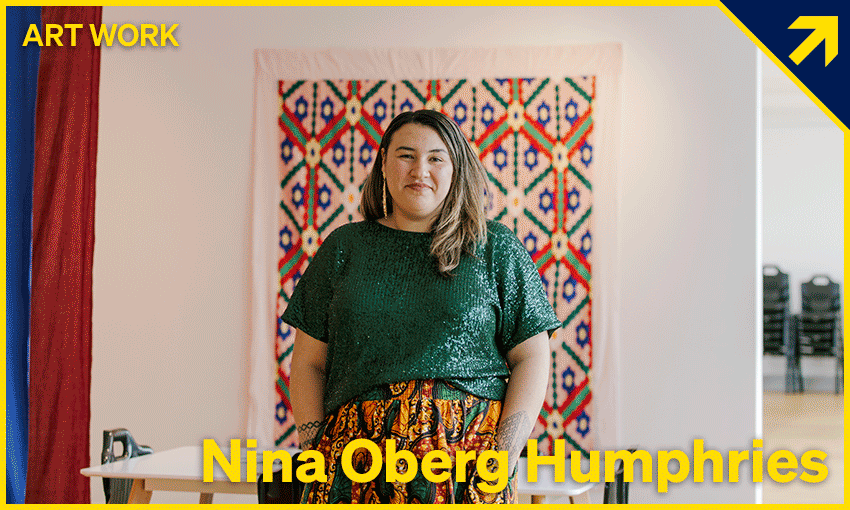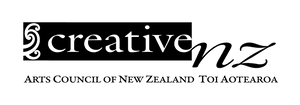In this instalment of Art Work, multimedia artist Nina Oberg Humphries talks about creating community, and how her art links her to home.
Nina Oberg Humphries is a multimedia artist based in Ōtautahi. Her practice explores the contrast between Cook Islands artefacts, performance, tradition and Western popular culture. She was awarded Canterbury University’s Macmillan Brown Artist in Residence and the Creative New Zealand Mana Moana cohort Scholarship in 2020. She is also the director and co-founder of the Tagata Moana Trust, a non-profit organisation whose mission is to drive STEAM pathways through Pacific arts, language and culture. Her work has been exhibited at the Christchurch Gallery, the Bergman Gallery, Enjoy, and The Physics Room.
What the working week looks like
My working week is extremely varied and has very long hours. I run a charitable trust that does STEAM (science, technology, engineering, arts and mathematics) education throughout the South Island for Pacific kids, through Pacific art, language and culture. We also run a hub in Ōtautahi and a Pacific gallery which is the first and only one in the South Island for Pacific artists to show work.
I also have my own arts practice, where I’m a multimedia artist using predominantly Cook Island spiritual items as a place of reference, and now I’m a mother of three children – a five year old, a three year old, and a one year old.
My work week generally is quite chaotic, and compartmentalised. The first thing I do is meet with staff and check in on the projects we have going on and what’s in the week ahead. We could have community groups coming in, have artistic workshops, have an exhibition opening, any of the above plus programmes with schools.
Then I quickly roll into admin: looking at things like finances, accounts receivable, accounts payable, reconciling accounts, and looking at budgets, for the week ahead, for the month ahead – where are we sitting, what’s our projected budget, what have we spent. All of that!
Then I’m looking at what proposals I might need to finish, or researching other ways to bring in money to run the organisation. That’s the first three days of the week. Our last two days of the week are more project-focused, and about delivering things.
Up until recently, it was just me and a part-timer who had been doing all that. We’ve now expanded to five staff – we’re all artists with our own practice, and we’re all cramming into delivering things.
All the admin
Organisation is not my strong suit. I’m more likely to react to what is in front of me, especially with so much going on. I tend to work on a 24 hour timetable, because I have so many various things that I’m doing.
When it comes to my arts practice and actually making, I could get about two to three hours of work a week to be actually making things. Then the rest is all research and admin. There’s no prescribed thing. It’s chaotic.
It’s trying to live every day and get to the next – making sure that the money is coming in, people are happy, and we’re still able to continue the work.
Finding the energy
The way in which I’ve coped with all of it is that I’ve amalgamated it all together. I founded Tagata Moana Trust out of a need that I saw, and it’s very much an extension of my community arts practice. Then I have my family, and my own making. But it’s all one.
The only way I could cope with it is to have it co-existing with each other, which does become problematic when you’re looking at things like burnout and always having to be on demand, particularly for wider communities. I support a lot of people in writing proposals, in thinking about their arts practices. I’m very concerned with what our Pacific platforms for our creatives look like in Christchurch, but that’s been out of a pure place of me growing up here and really needing to see those platforms, having a lot of talent here but nowhere necessarily to nurture that – and losing everybody to Auckland.
It’s very difficult to be able to put yourself first, but I think that when you have kids, you relinquish that anyway. So the only way that I’ve been able to continue an artistic practice is to be within the context of this Trust that I’ve created. I’ve created my own artistic job and I’ve been able to be financially okay as a creative person.
Working on my own artistic practice
I spend a lot of time thinking about what I’m going to do when I have a project coming up, whether it’s an exhibition, a commission, or even just a lull in the calendar because my hours are so limited in terms of production. I might get just three hours a week, or I might have a month from now where I have a moment, where I realise that to look after myself this week, I need to have it off to be able to make something.
That process is purely hands-on. I work a lot with new materials and it’s an exploratory time with those materials, or about trying to knock out some work for an exhibition. It almost becomes quite manic, and there’s a lot of pressure involved because there’s such limited time to be able to produce the work and make sure there’s still a high quality of production.
Over the last couple of years, I’ve been making work that is about Cook Island spiritual items – taura atua. The word “taura” can mean many things, but for most Pacific languages, it means “to be anchored” or “to be an anchor”, or a cord. Making these objects is something that I’ve been really interested in because they’re of a pre-colonial time, they speak about spirituality, personal spirituality and multiple gods, which is something that isn’t supported today in the Cook Islands, and those memories are really disappearing.
So when I make these items, or these taonga, it’s about trying to recreate the same kind of spiritual energy in which they would have been made.
When I’m making, it’s quite meditative. It’s a spiritual practice. It is the way in which I refill my cup and my energy. That taura, or that cord, back into my ancestor or my place, where I’m from, particularly not being born in Christchurch, as a second generation Cook Islander. That time in the studio is incredibly spiritual practice for me.
Other than that, there’s times where I’ve gone in to make stuff and I can only think of it as going into a dark hole – I go in there and make and then when I reach a switch in energy, I’m coming out and I’ve produced this piece. It’s a religious and spiritual practice for me, that is formed in these objects.
What would make it easier
The biggest shift would be if people actually valued the arts. Without art, we do not have creativity. Without creativity, we do not have innovation. Without innovation, we do not have solutions. Without solutions, we, as a society, as a world, as a universe, will cease to exist.
So when art and being creative is put on the social ladder as being something that you can’t make money from or is airy-fairy, that devalues it. Artists comment, we capture our changing world, our changing environment. We leave the world open for there to be able to be change and innovation so the world, and our societies, can continue.
Art is life, life is art. We don’t have a word in Pacific languages that actually translates to the word “art” because everything is so intrinsically part of being creative and connecting to your spirituality inside, so then we can be more connected as people to our environment, and to each other.
I’d like to see every single person value the arts as the centre of everything, because it is our well-being. It is our health. And it is our future. As long as we deny that, we continue to not reap the benefits of what our futures could look like, and how prosperous it could be to everybody.
What structural changes would help?
I think we [in the South Island] need more support, because I don’t think we’ve been afforded the opportunity to envision in the same way. Our audiences haven’t been as developed, our programming isn’t as developed, our institutions aren’t as developed.
There’s obviously a huge gap and that will predominantly be funding related. We need more support, but at the same time, we do need to find ways in which we sustain ourselves without having to be under anybody, or reliant on anybody.
What makes it all worth it
We’ve got an exhibition soon, and I know I’m going to be stressed the whole time – until we get to about 9pm on Friday when everybody’s been kicked out the door, and it’ll feel like a blur. But I’ll remember the little conversations I have with people, or the kid who comes in and gets to experience some of their culture for the first time.
It’s the projects coming to fruition – to be able to look at them and go, “Oh yeah, that’s good!” – and celebrating those projects. You’ve got to do your admin, but when you get to the end of that, it’s about the project. It’s about the thing you’ve created or done, it’s about the smiles on people’s faces.
– As told to Sam Brooks

